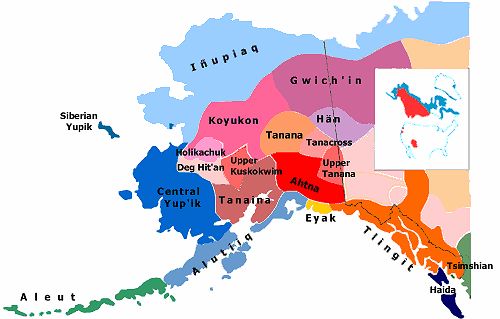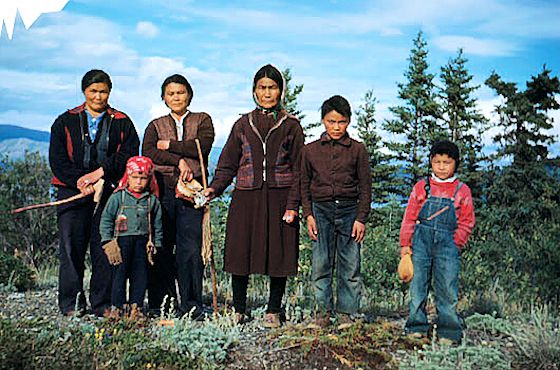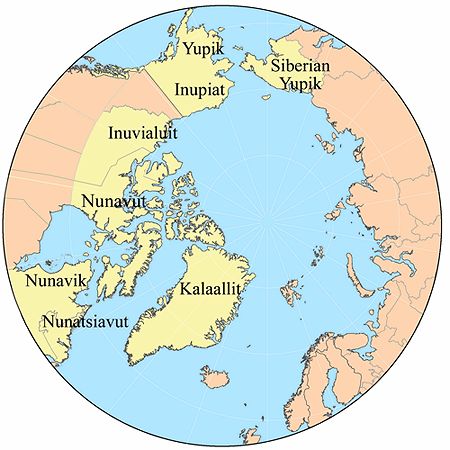The historical trauma that my community has experienced is still with us today and manifests itself in the social ills of poverty. Yet, it is the rich culture provided by the wealth of the land and sea that defines the health of our community. Just as in Inupiaq times, when men and women, elders and youth had vital and equally important roles to play in the success of a community, we all have roles today. All of our institutions have roles to play.
Arctic Tribes
Ethnographers commonly classify indigenous peoples in the United States and Canada into ten geographical regions with shared cultural traits (called cultural areas). The following list groups peoples by the Arctic region.
The Arctic culture area is a cold, flat, treeless region (actually a frozen desert) near the Arctic Circle in present-day Alaska, Canada and Greenland.
It is home to the Inuit and the Aleut. The Inuit and Aleut groups speak dialects descended from what scholars call the Eskimo-Aleut language family.
Because it is such an inhospitable landscape, the Arctic’s population was and is comparatively small and scattered. Some of its peoples, especially the Inuit in the northern part of the region, were nomads, following seals, polar bears and other game as they migrated across the tundra.
In the southern part of the region, the Aleut were a bit more settled, living in small fishing villages along the shore.
This section provides general information for collective groupings of tribes, bands, and villages who share cultural traits and live in the Arctic geographical region.
See Alaskan Natives A to Z for information specific to individual federally recognized tribes or villages in Alaska, which may not apply to all tribes who share their culture group.
Click image to enlarge.
Location:Alaska, parts of Canada, eastern Siberia (Russia), and GreenlandAlso see: Villages by Region
The Arctic Region
The Arctic Culture Area spreads across northern North America and is an area which can be described as a cold desert. It is a region which lies above the northernmost limit of tree growth. The area has long, cold winters and short summers. Everything freezes for 9 to 10 months of the year. Cold, icy winters have below freezing temperatures and small amounts of daylight.During the summer, the tundra becomes boggy and difficult to cross, and has long periods of daylight, up to 20 hours a day.The Arctic Region runs across modern northern Canada and the two oceans from modern Siberia to Greenland (5000 miles long). It includes 3 oceans and the Arctic circle.
Paleo-Eskimo, prehistoric cultures, Russia, Alaska, Canada, Greenland, 2500 BCE–1500 CE
Arctic small tool tradition, prehistoric culture, 2500 BCE, Bering Strait
Pre-Dorset, eastern Arctic, 2500–500 BCE
Saqqaq culture, Greenland, 2500–800 BCE)
Independence I, northeastern Canada and Greenland, 2400–1800 BCE
Independence II culture, northeastern Canada and Greenland, 800–1 BCE)
Groswater, Labrador and Nunavik, Canada
Dorset culture, 500 BCE–1500 CE, Alaska, Canada
Aleut (Unangan), Aleutian Islands of Alaska, and Kamchatka Krai, Russia
Inuit (Eskimo), Eastern Siberia (Russia), Alaska (United States), Canada, Greenland (Denmark)
Thule, proto-Inuit, Alaska, Canada, Greenland, 900–1500 CE
Birnirk culture, prehistoric Inuit culture, Alaska, 500 CE–900 CE
Greenlandic Inuit people, Greenland
Kalaallit, west Greenland
Avanersuarmiut (Inughuit), north Greenland
Tunumiit, east Greenland
Inuvialuit, western Canadian Arctic
Iñupiat, north and northwest Alaska
Yupik (Yup’ik and Cup’ik), Alaska and Russia
Alutiiq people (Sugpiaq, Pacific Yupik), Alaska Peninsula, coastal and island areas of south central Alaska
Central Alaskan Yup’ik people, west central Alaska
Cup’ik, Hooper Bay and Chevak, Alaska
Nunivak Cup’ig people (Cup’ig), Nunivak Island, Alaska
Siberian Yupik people, Russian Far East and St. Lawrence Island, Alaska
Chaplino
Naukan
Sirenik, Siberia
Arctic
California
Northeast
Great Basin
Great Plains
NW Coast
Plateau
Southeast
Southwest
Sub Arctic
Several thousand years ago, before European explorers discovered the shores of the Aleutian Islands, they were inhabited by the “Unangas” (Aleut people).
Who are the Athabaskan peoples?
25 ViewsAthabaskan is the name of a language group, also called Na-Dene or Apachean, that includes languages associated with Native American and First Nation people that today live in Alaska, northwest Canada, and coastal Oregon and California.
Alutiiq / Sugpiaq
22 Views
The Alutiiq people are also referred to as Aleut (plural form “Alutiit“), also called by their ancestral name Sugpiaq (plural form “Sugpiat” or “Sugpiak“) as well as Pacific Eskimo or Pacific Yupik. At present, the most commonly used title is Alutiiq (singular) or Alutiik or Alutiit (plural). They are not to be confused with the Aleuts, who live further to the southwest, including along the Aleutian Islands. The Alutiiq are a southern coastal Native people of Alaska.
Eskimo Culture
22 ViewsEskimos are indigenous peoples who have traditionally inhabited the circumpolar region from eastern Siberia (Russia), across Alaska (United States), Canada, and Greenland. There are two main groups that are referred to as Eskimo: Yupik and Inuit. A third group, the Aleut, is related.

